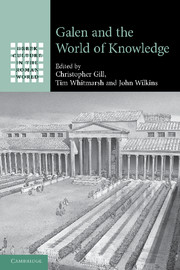Book contents
- Frontmatter
- Contents
- Notes on contributors
- Note on conventions
- Preface
- Introduction
- 1 Galen's library
- 2 Conventions of prefatory self-presentation in Galen's On the Order of My Own Books
- 3 Demiurge and Emperor in Galen's world of knowledge
- 4 Shock and awe: the performance dimension of Galen's anatomy demonstrations
- 5 Galen's un-Hippocratic case-histories
- 6 Staging the past, staging oneself: Galen on Hellenistic exegetical traditions
- 7 Galen and Hippocratic medicine: language and practice
- 8 Galen's Bios and Methodos: from ways of life to path of knowledge
- 9 Does Galen have a medical programme for intellectuals and the faculties of the intellect?
- 10 Galen on the limitations of knowledge
- 11 Galen and Middle Platonism
- 12 ‘Aristotle! What a thing for you to say!’ Galen's engagement with Aristotle and Aristotelians
- 13 Galen and the Stoics, or: the art of not naming
- Bibliography
- Index
4 - Shock and awe: the performance dimension of Galen's anatomy demonstrations
Published online by Cambridge University Press: 06 August 2010
- Frontmatter
- Contents
- Notes on contributors
- Note on conventions
- Preface
- Introduction
- 1 Galen's library
- 2 Conventions of prefatory self-presentation in Galen's On the Order of My Own Books
- 3 Demiurge and Emperor in Galen's world of knowledge
- 4 Shock and awe: the performance dimension of Galen's anatomy demonstrations
- 5 Galen's un-Hippocratic case-histories
- 6 Staging the past, staging oneself: Galen on Hellenistic exegetical traditions
- 7 Galen and Hippocratic medicine: language and practice
- 8 Galen's Bios and Methodos: from ways of life to path of knowledge
- 9 Does Galen have a medical programme for intellectuals and the faculties of the intellect?
- 10 Galen on the limitations of knowledge
- 11 Galen and Middle Platonism
- 12 ‘Aristotle! What a thing for you to say!’ Galen's engagement with Aristotle and Aristotelians
- 13 Galen and the Stoics, or: the art of not naming
- Bibliography
- Index
Summary
GALEN'S ANATOMICAL PERFORMANCES
Just as those who describe the nature of a country show its delimiting boundaries first, and then proceed to the elucidation of its component parts, so I too will begin by describing the delimiting boundaries of the thorax.
ὥσπερ οὖν, ὅσοι διηγοῦνται φύσιν χωρίου, τοὺς περιγράφοντας ὅρους αὐτὸ πρότερον δηλώσαντες, ἑξῆς ἐπὶ τὴν ἑκάστου τῶν μερῶν ἀφικνοῦνται διδασκαλίαν, οὕτως κᾀγὼ τοὺς περιγράφοντας ὅρους τὸν θώρακα προτέρους διηγήσομαι.
(Anatomical Procedures Kühn II.652)When Galen invites us to visualise the thorax as a geographical formation, he represents the body as a world of knowledge, and presents himself as its periegete. The body is a metaphor for the world. Marcus Aurelius, for example, Galen's own emperor, saw the whole order of creation as a body: he compares the selfish and wilful man, who has cut himself off from the unity of nature, to a severed hand or foot or head, lying apart from the rest of the body to which it belongs. The intact body is a powerful symbol of organic unity and, at least to the ancients, the smooth functioning of its component parts under central direction was a figure for the smooth functioning of a hierarchical society. Conversely, the body that has been marked or mutilated, whose interior has been exteriorised and laid open to public view, was a symbol of disturbing resonance and enduring fascination.
- Type
- Chapter
- Information
- Galen and the World of Knowledge , pp. 85 - 114Publisher: Cambridge University PressPrint publication year: 2009
- 31
- Cited by

